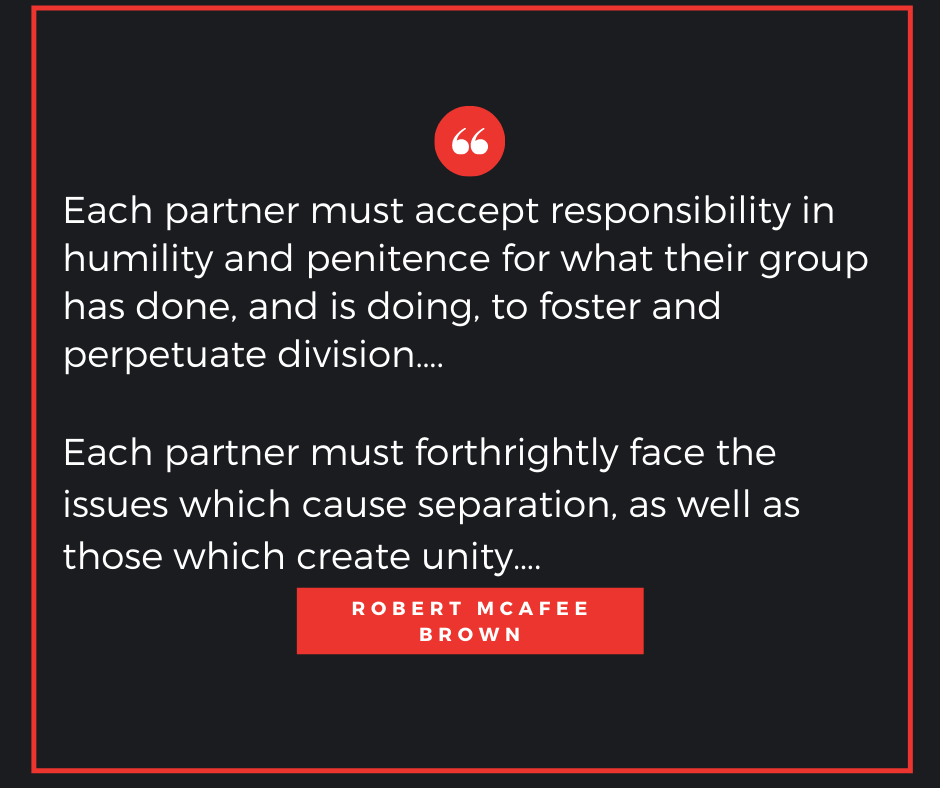Ecumenical Dialogue and the Journey from Enmity to Community
In the centuries preceding the establishment of the United States, Christians slaughtered each other. Lutherans and Calvinists could not abide Mennonites or Arminian Baptists. Even in the American colonies, Quakers endured deadly persecution for, among other matters, shaking hands in lieu of dipping hats; and Protestant Nativists terrorized the growing Catholic immigrant population in the middle 1800s.
Yet, by the mid-20th century, the Christian ecumenical movement was hailed as “the great new fact of our era.” Currents created by Western Christians re-thinking what missions meant, collaborating in the midst of wars to find a common vision for more just and peaceful societies, and seeking to find expressions of the church that expressed unity without uniformity converged. After centuries of mutual murders, anathemas, insults, and persecutions, scores of communions/denominations prayed together, shared scholarship, marched arm-in-arm in civil rights demonstrations, and took steps toward shared communion.
Granted, the ecumenical movement in no way involves ALL the churches of Western Christianity and their missionary plantings. Many conservative Protestants rebuked the movement toward visible unity as a modern Tower of Babel (including the people who became the Religious Right). Catholic leaders after Vatican II opened some windows, and guarded the doors. Eastern Orthodox participated vigorously without giving a millimeter on who comprises the One True Church. But, it is remarkable how deeply rooted, centuries’ old traditions of enmity yielded—in part—to a different Spirit.
So, I wondered: is there anything learned in this ecumenical journey from enmity to community that might be useful for the U.S. in our era of toxic polarization?
Maybe.
First, the ecumenical movement was impossible until churches were disarmed. With the power of the sword confiscated by the state, either in the form of toleration or religious freedom, churches could no longer seek to purify society by eliminating their doctrinal foes. The work of persuading free consciences to live and work together is not effectively done at the tip of a sword or the barrel of a gun. The First Amendment is, as one commentator aptly wrote, an article of peace rather than an article of faith.
Second, the ecumenical movement moves slowly. There is more than one “frozen chosen” denomination. Efforts toward ecumenical agreements are judged by whether or not they are “ripe” or “mature.” Ecumenical dialogue does not inevitably lead forward; sometimes it fails to produce. It is not for the impatient or those whose horizon is measured in months or years rather than decades or centuries. Dialogue requires persistence and grit.

Third: the movement succeeds when both the grassroots and leaders are engaged. In hierarchical communions, “the faithful” may follow leadership—or not. Matured documents, the results of long years of work, were greeted by yawns from the pews. Laity taking ministry into their own hands and forging local partnerships were sometimes roped in by the hierarchy. Leaders can set a tone and can create temporary leaps by a grand gesture, e.g., sharing wedding duties or con-celebrating communion. But if either laity or the hierarchy remains parochial, then ecumenical (which is the opposite of parochial, meaning “the whole inhabited world”) ventures are inert.
Fourth, the practice of ecumenical dialogue over the decades produced guidelines for productive dialogue, based on the requirements of honesty and trust. The set of guidelines I like best were offered by theology professor and Presbyterian ecumenical statesman, Dr. Robert McAfee Brown.
-
Each partner must believe that the other is speaking in good faith.
-
Each partner must have a clear understanding of their own faith
-
Each partner must strive for a clear understanding of the faith of the other. Corollaries: “a willingness to interpret the faith of the other in its best rather than its worst light” ; “maintain a continual willingness to revise their understanding of the faith of the other.”
-
Each partner must accept responsibility in humility and penitence for what their group has done, and is doing, to foster and perpetuate division….
-
Each partner must forthrightly face the issues which cause separation, as well as those which create unity….
-
Each partner must seek to make the dialogue a source of renewal in their own church.”
Robert McAfee Brown, The Ecumenical Revolution. 1967, 70-77.
Now, read these guidelines again with a divided nation in mind:
-
Each elected official must believe that the other is speaking in good faith. [and based on seeing each other as members of the same nation]
-
Each partner must have a clear understanding of their own position
-
Each partner must strive for a clear understanding of the position of the other. Corollaries: a willingness to interpret the position of the other in its best rather than its worst light; maintain a continual willingness to revise their understanding of the position of the other.
-
Each partner must accept responsibility in humility and penitence for what their party has done, and is doing, to foster and perpetuate division….
-
Each partner must forthrightly face the issues which cause separation, as well as those which create a common good
-
Each partner must seek to make the dialogue a source of renewal in their own party.
What happens if you try to sit down with loaded (political and sometimes real) weapons on the table, expecting to run a sprint rather than a marathon, without alignment between leaders and followers, assuming the worst intentions on the other side and unwilling to see anything wrong with your own position and party?
You know what happens, for we see it every day.
One could argue that the aspiration of e pluribus unum is a kind of ecumenical movement for the U.S. And, by looking at the virtues of what engagement in the ecumenical movement has required, we might conclude that “we the people” have a long road ahead of us if that national motto is going to sharpen into reality rather than fade into history.
Dr. Gary Peluso-Verdend is president emeritus at Phillips Theological Seminary and is the executive director of the seminary’s Center for Religion in Public Life. The opinions expressed in this blog are those of the author. Learn more about the Center’s work here and about Gary here.


Comments are closed.